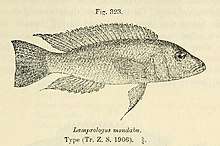Neolamprologus mondabu
Neolamprologus mondabu is a species of cichlid endemic to Lake Tanganyika except for the southern portion where it is replaced by N. modestus. It prefers areas with rocky substrates, moving to areas with sandy substrates to breed. It feeds on the eggs of Lamprichthys tanganicanus. This species can reach a length of 10.7 centimetres (4.2 in) TL. This species can also be found in the aquarium trade.[2]
| Neolamprologus mondabu | |
|---|---|
 | |
| Scientific classification | |
| Kingdom: | Animalia |
| Phylum: | Chordata |
| Class: | Actinopterygii |
| Order: | Cichliformes |
| Family: | Cichlidae |
| Genus: | Neolamprologus |
| Species: | N. mondabu |
| Binomial name | |
| Neolamprologus mondabu (Boulenger, 1906) | |
| Synonyms | |
|
Lamprologus mondabu Boulenger, 1906 | |
Female Neolamprologus mondabu can dig pits in the bottom substrate to facilitate feeding of their offspring. Such maternal food provisioning is unusual and is not known among other African substrate-brooding cichlids, but similar behaviour has been observed in Central American cichlids.[3]
References
- Bigirimana, C. (2006). "Neolamprologus mondabu". IUCN Red List of Threatened Species. 2006: e.T60606A12382883. doi:10.2305/IUCN.UK.2006.RLTS.T60606A12382883.en.
- Froese, Rainer and Pauly, Daniel, eds. (2013). "Neolamprologus mondabu" in FishBase. February 2013 version.
- Ota, K.; Kohda, M. (2014). "Maternal Food Provisioning in a Substrate-Brooding African Cichlid". PLoS ONE. 9 (6): e99094. doi:10.1371/journal.pone.0099094. PMC 4049616. PMID 24911060.
This article is issued from Wikipedia. The text is licensed under Creative Commons - Attribution - Sharealike. Additional terms may apply for the media files.
